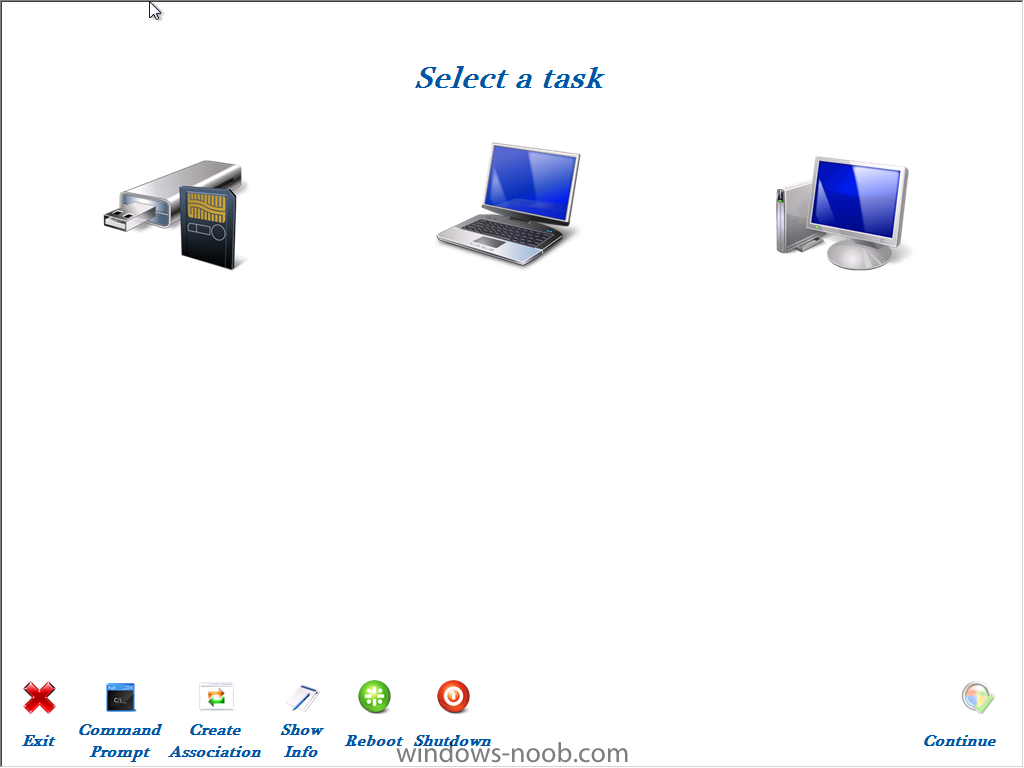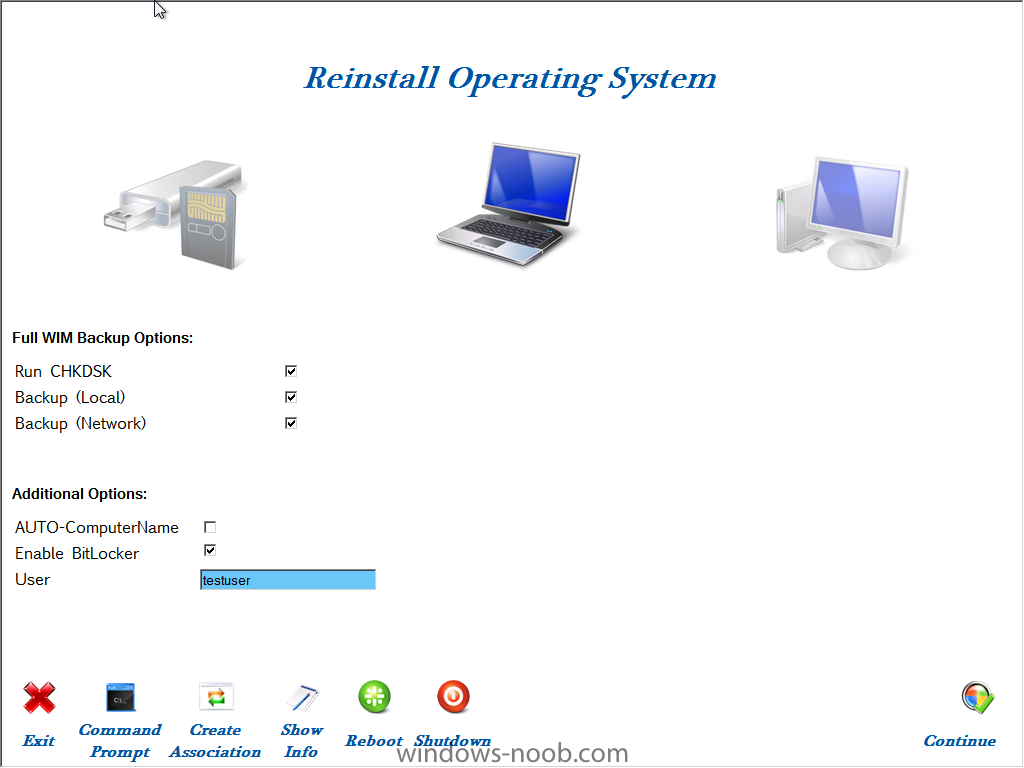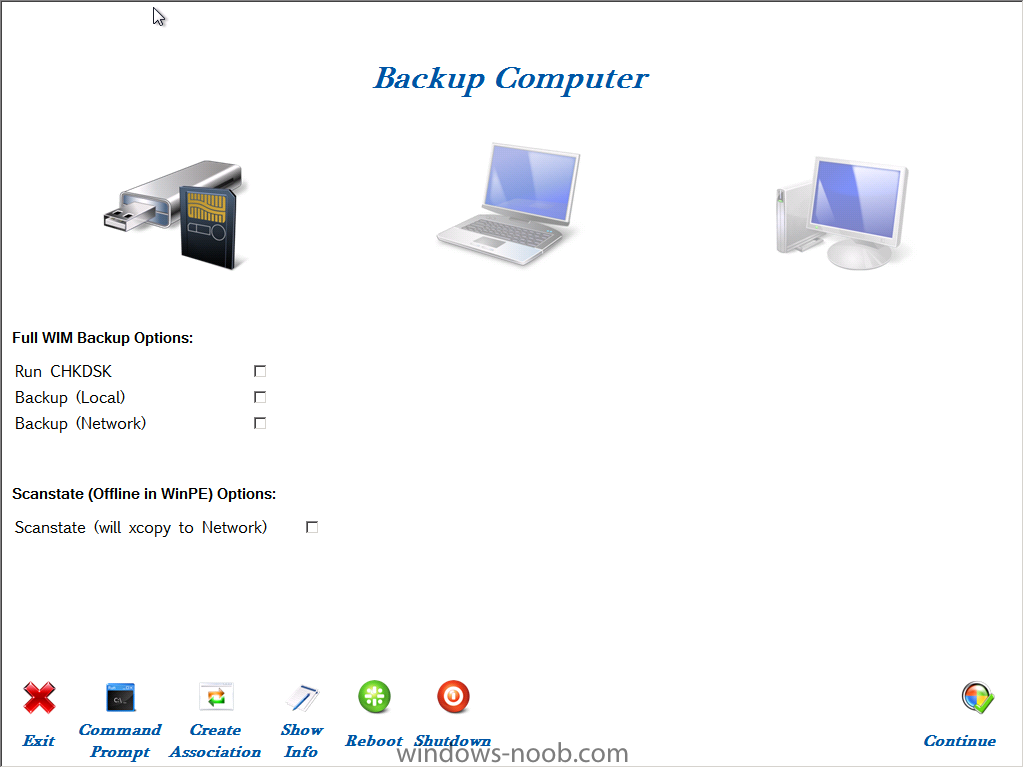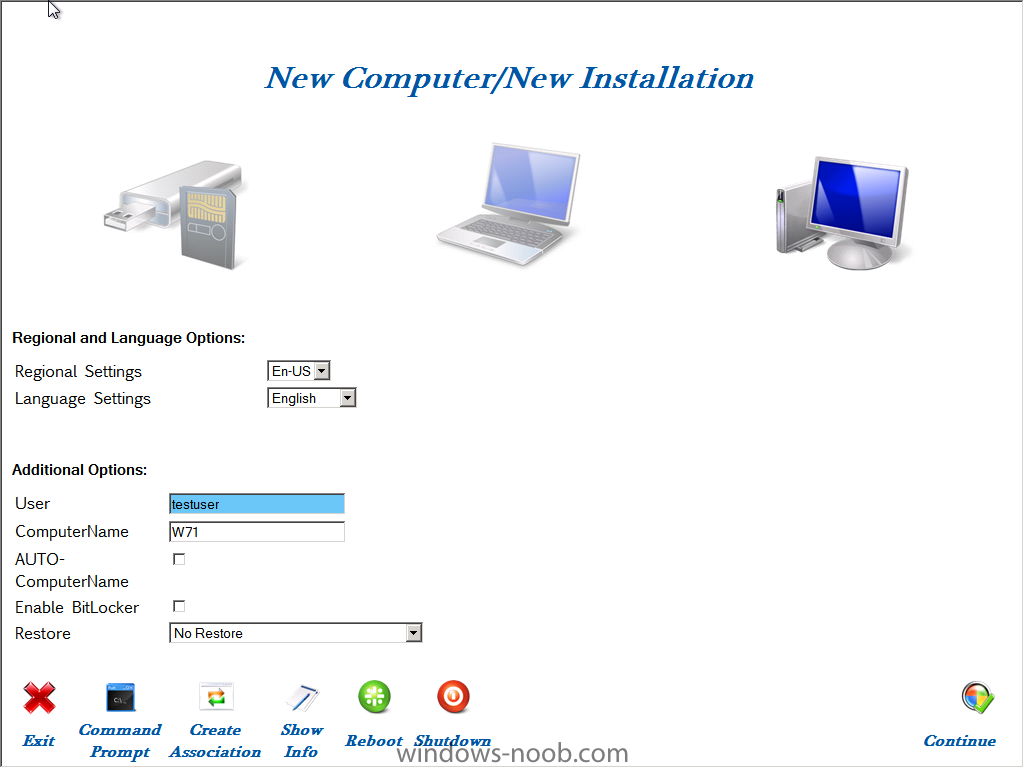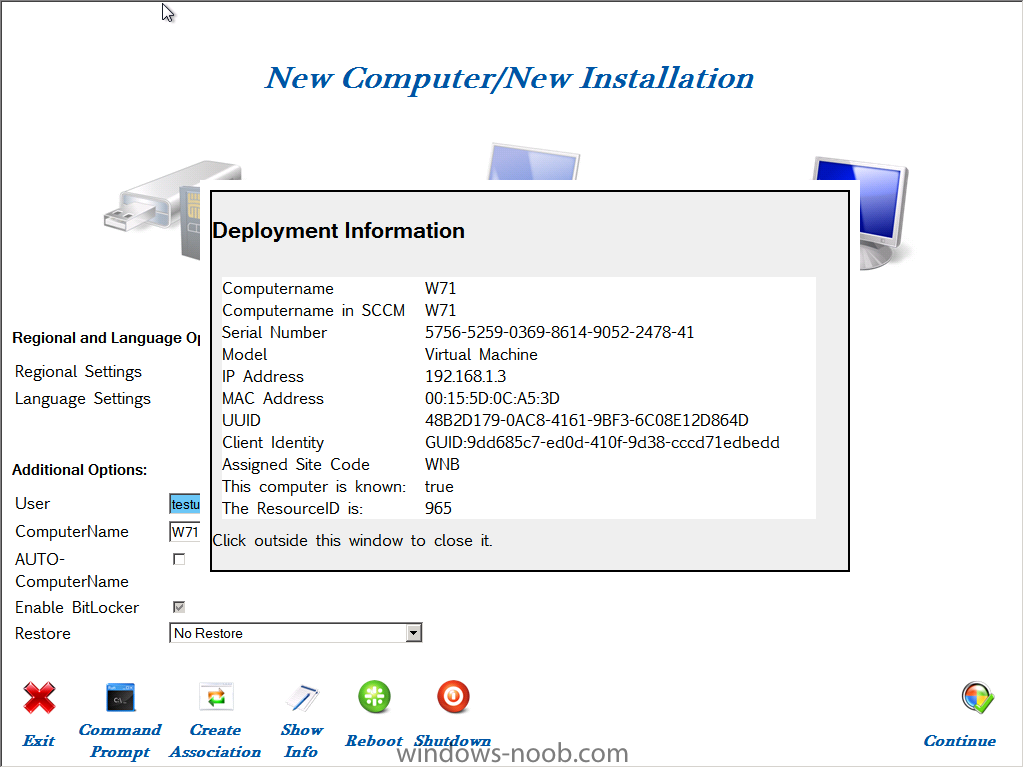-
Posts
9250 -
Joined
-
Last visited
-
Days Won
369
Everything posted by anyweb
-
look at the task sequence in the screenshot below, notice that the Restore user state happens AFTER Setup Windows and ConfigMgr, in other words, in Windows... is yours before or after that step ?
-
that;s not what i'm referring to, the step 'restore user state' must be running in the Full OS, not in WinPE which is what caused your error.
-
you are probably trying to run the command in windows PE which isnt supported, so check where you are trying to run the step, you need to restore user state in full windows... Failed to run the action: Restore User State. The request is not supported. (Error: 80070032; Source: Windows) TSManager 17/01/2012 5:17:51 PM 1456 (0x05B0)
-
it was great, i'll be presenting in about an hour so wish me luck 8 demos planned
-
i'm off to this tomorrow, i'll be presenting on Wednesday, talking about Patch Management (SUP) within configuration Manager 2012, looks like it's going to be a packed two days ! System Center Configuration Manager 2012 Summit http://www.cornersto...Event/sccm2012/ Niall Brady, Enfo Zipper MVP in System Center Configuration Manager Niall Brady is an Irish man living in Sweden, he’s been working with computers since the early 90’s and is an MVP in System Center Configuration Manager. Niall has a strong passion for deploying Operating Systems and can be found online helping others on the Technet forums or blogging about his experiences at MyITForum. Niall run’s a forum dedicated to ConfigMgr called windows-noob.com. Johan Arwidmark, Knowledge Factory Johan Arwidmark behöver knappast en presentation! Johan har idag ett uppdrag som Chief Technical Architect hos Knowledge Factory. Utöver det är han också författare och all-around geek med fullt fokus på Enterprise Windows Deployment lösningar. Johan är känd på scen för sin energiska och humoristiska stil som han blandar med mycket live demos av ibland mycket komplex teknik som när Johan presenterar den, ser enkel ut! Jörgen Nilsson Hösten 2010 var Jörgen en av topp-talarna på Best of MMS i Stockholm och blev samtidigt också medlem i <a href="http://technet.microsoft.com/sv-se/cc299419" target="_blank">MEET. Under våren 2011 gjorde Jörgen talardebut på Microsoft Techdays i Örebro. I den senaste raden av utmärkelser är det värt att nämna att Jörgen blivit MVP inom SCCM för sitt arbete med att hjälpa och dela sin kompetens på Microsofts communityn. Anders Ahl Redan 1997 skrev Anders sin första bok om Systems Management och har sedan dess vänt ut och in på de flesta produkter på marknaden inom detta området. Sedan 2006 jobbar Anders som Principal Consultant på Microsoft Consulting Services med Systems Management i allmänhet och OS Deployment i synnerhet. Anders hittas oftast längst upp på barrikaden när det är nya produkter på gång och han har drivit flera TAP & RDP-program för Windows 2008, Windows 7 och nu senast SCCM 2012. Johan Bång Johan intresserade sig tidigt för molntjänster och deras möjligheter. Idag arbetar Johan på Retune som seniorkonsult och Cloud Advisor. Främst med fokus på Microsofts klientrelaterade molntjänster som Office 365 och Intune. Med Johans erfarenhet och bakgrund blir det alltmer fokus på strategiska frågor och att hjälpa företag med vägledning inom privata och publika molnstrategier.
-
well if you didnt find the user state then either scanstate or loadstate failed, review the logs to find out which did (usually scanstate fails, so review scanstate.log)
-

Windows 7 deployment to remote site with WDS
anyweb replied to vinjas's question in Deploying Windows 10, Windows 8.1, Windows 7 and more...
and for those searching for the same problem the answer for you was to....? -

Failed to Run Task Sequence - Plz Help
anyweb replied to kingshillbilly's topic in Configuration Manager 2012
post the smsts.log here please -

using SCCM 2012 beta 2 in a LAB - Part 1. Installation
anyweb replied to anyweb's topic in Configuration Manager 2012
I would recommend you forget about beta 2 and look at my guides for installing Release Candidate instead, the issue you are having does ring a bell however and as far as i remember it was to do with sql itself and what account is was running under, changing it to Local System seemed to be the fix -

Password Protect a Task Sequence?
anyweb replied to thadkew's question in Frontends, HTA's and Web Services
integrate mdt 2010 update 1 with configmgr, go through the wizard in task sequences to create a Microsoft Deployment Toolkit task sequence, easy. done. -

Strange things happened: Wrong workstations reinstalled
anyweb replied to silverSl!DE's question in Deploy 7
oops ! better have a read of this then:- How can I password Protect a Task Sequence ? Password Protecting a Task Sequence -
well check by enabling command prompt support, without an ip it will reboot
-
hi paul looks like your boot image is corrupt try re-distributing it to your distribution points and try again
-
what vm are you using ? is it vmware ? you probably need to add network drivers to your boot image, enable command prompt support in your boot image to test the theory before it reboots that is.
-

how can I setup WDS in Windows Server 2008
anyweb replied to anyweb's question in Windows Deployment Services
try right clicking and choose Run As Administrator, then try the same thing again... -

Are HTA frontends needed with SCCM 2012?
anyweb replied to GeoffW's topic in Configuration Manager 2012
HTA's provide additional functionality and customizability that doesn't exist in the product out of box, so you will most likely see many HTA's for SCCM 2012 once it finally goes RTM. -

Introducing: The BitLocker Frontend HTA
anyweb posted a question in Frontends, HTA's and Web Services
The next logical step for the windows-noob.com FrontEnd HTA which I released back in April 2011 was to add support for BitLocker, and I've added it along with some bugfixes, a new clean look, and some new functionality. What does it do ? first of all what does this HTA do ? it allows you to PXE boot into Windows PE (yes, PE) and do three types of common scenarios for migrating your computers to Windows 7 with BitLocker. backup old computer (full WIM backup locally, full wim backup to network, chkdsk, offline scanstate to Network folder reinstall computer (reinstalls/refreshes Windows 7 on an Windows XP or Windows 7 computer and supports the following scenarios: where BL=BitLockered and UBL=Not BitLockered XP>7 BL XP>7 UBL 7BL>7UBL 7UBL>7BL 7BL>7BL 7UBL>7UBL New Computer (new installation of Windows 7 with or without BitLocker). In addition to the above you can do the following:- computer associations in WinPE auto-computername (using Michael Niehaus RIS style naming web service) select a language to install during New Computer deployment select regional settings during New Computer deployment see the current computername and change it Input a username and that user becomes the local administrator show info relating to Computername, computername in SCCM, Serial Number, Model, IP address, Mac Address, UUID, Client Identity (GUID), Assigned Site Code, Resource known/unknown, Resource ID supports SMP backup in addition to full wim local, full wim network, and offline mode in WinPE detects if the hardware is Lenovo or Dell and has driver steps included for some common models (you have to download the driver packages yourself however) detects and interogates the TPM/Bios on Dell and Lenovo hardware to prepare it for BitLocker if no TPM found it disables the BitLocker Capability in the HTA if virtual hardware detected, it disables BitLocker capability (however you can enable this just for testing) has the ability to Notfiy the end user if the task sequence was successful or unsuccessful creates a REG key to add succesful task sequence, creates a text file in c:\ to demonstrate successful task sequence cool, yep, very cool. Requirements:- This is not for the faint hearted, you'll need to have the following working before attempting this:- For the reinstall BitLockered computer scenario we need to get our BitLocker recovery key from an MBAM database described here A good understanding of BitLocker, here's some guides i've written about it MDT 2010 update 1 integrated with ConfigMgr Maik Kosters Web Services 7.2 installed - quick quide here SCCM 2007 SP2 R2 or later Implement Offline scanstate in WinPE as shown here Install Language packs Offline using SCCM 2007 sp2 ok enough already give it to me ! Download the ZIP here it is, download this and import the task sequence XML file, copy the WNB and BitLocker folders as sub-directories of a newly created MDT Files package. Update your MDT Files package and get started Note: If you downloaded the ZIP before 12th of January then download it again as I fixed a few bugs in the task sequence. The BitLocker HTA.zip Show me some screenshots here's some screenshots:- The Backup computer screen The Reinstall Computer screen with BitLocker checkbox enabled The New Computer Screen with the BitLocker checkbox unchecked Show Info Screen I'll post bugfixes and known issues shortly as they roll in, if you are in any way struggling with this then read the windows-noob.com Frontend HTA guide here please as it explains how to get this all working. Known Issues * BitLocker doesn't get enabled if you use the Microsoft supplied EnableBitLocker.vbs script when also selecting a Language pack. Solution. Replace the script with EnableBitLocker_Multi.vbs instead or use the built in Enable BitLocker step (note that step doesn't have as much customization built in as the script does). * Regional And Language settings may not be applied properly causing task sequence failure. Solution, make sure that you are using the correct architecture XML file in the Apply Operating System Step otherwise it will fail., in addition your Language Pack files packages must match the architecture you are deploying, for example, if you are deploying Windows 7 X64 then your language packages must also be X64 or the task sequence will fail to add languages and additionally fail to add the custom local administrator if one is specified. This is not a bug in the task sequence ! Add the correct architecture Language pack files and unattend.xml and all is good. * All Loadstate functions are hard coded for X64 OS. Solution, the task sequence assumes you are deploying Windows 7 X64 OS, if you want to deploy Windows 7 X86 you can enable the X86 steps in the task sequence and add some logic to detect if the os is x86 or x64 and act accordingly, if i have time i will re-release a version of this with the logic in it. * Icons not displaying or red X appearing where the icons should be on bare metal (new computer) scenarios .... Solution, make sure that the hard disc is partitioned and formatted before testing the HTA. cheers ! niall. -
good stuff, check your personal message i sent you cheers niall
-
that's only the index of updates, ie: whats available, so unless you downloaded everything you've nothing to be concerned about if you want to verify that look at whether each update is downloaded or not, also, to sort the updates use the Search ability and add criteria, for example type in definition updates in the search field and click search
-
well i dont know how you can boot into winpe to the sccm 2007 server and switch to another server mid install, it doesnt work like that, it's either one or the other, how would the cm12 server know that you pxe booted ? how would it know that you selected an advertisement/deployment, what i'd suggest you do is pxe boot on the CM12 side and install your computers there, or is there a reason not to do this ?
-
Configuration Manager 2012 is still in release candidate so unless you are a TAP customer you shouldn't have it installed in production, so are you ?
-
MDOP requires a specific license from Microsoft, you need to talk to your Microsoft Technical Account Manager for assistance with that, cheers




